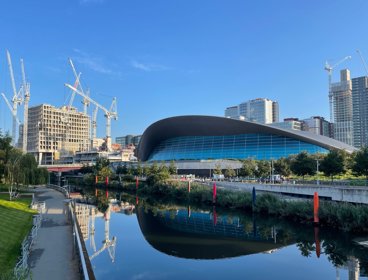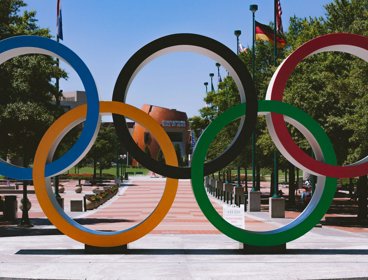London 2012: the most sustainable Olympic Games to date. That was premise on which the city based its bid. Boasting the most sustainable Olympic and Paralympic Stadium ever built and promising a zero-waste Games, it certainly appears that the ecological principles of the bid are being upheld (London 2012). However, has this mega-event really been as green as it promised?
To find out, we spoke to Professor Allan Brimicombe, Head of the Centre for Geo-Information Studies at the University of East London. He uses data analysis and spatial modelling to solve complex problems, such as asking whether London 2012 is sustainable or not.
Allan is leading a series of impact studies for the London Organising Committee of the Olympic Games and Paralympic Games (LOCOG) to assess the environmental, socio-cultural economic effects of London 2012.
Why did London 2012 commit to the vision of being the “first truly sustainable Games”?
London had to sell its bid to the International Olympic Committee (IOC) and had tough competition from Paris and Madrid, who were also involved in the final rounds of bidding for the 2012 Games. Each city needed a Unique Selling Point (USP) to interest the client – in this case, the IOC. So this is all a question of branding. Alongside London 2012’s overarching aim of ‘inspiring a generation’ the London Games also aimed to regenerate East London and the environmental impact was an important consideration within this.
Olympic Charter: Mission and role of IOC:
13. to encourage and support a responsible concern for environmental issues, to promote sustainable development in sport and to require that the Olympic Games are held accordingly
14. to promote a positive legacy from the Olympic Games to the host cities and host countries;
Sustainability fits with the Olympic Charter’s aims of being of sustainable and promoting a positive legacy. If you are going to have a large transformational impact on East London – a transformation that is inspiring a generation – it makes sense for it not just to be here today and gone tomorrow. This legacy has to stick for decades to come and using a sustainable approach is more likely to make this happen.
If London 2012 was being branded as a 'truly sustainable' Games, who was it being sold to?
This was a vision being sold to the IOC, to commercial sponsors and also to Londoners. But, first and foremost, it had to be accepted by the IOC. Without a contract to host the Games, nothing would happen. At the same time, however, you need your sponsors and the nation behind you once you have won the bid to host the Games.
Within London, there was already a movement towards being greener, more environmentally friendly and, therefore, increasingly sustainable. We have seen this trend being reflected in Government policy for the last 10-15 years, and in the choices being made by consumers. London 2012’s commitment to sustainability fits with the general mood in Britain.
What does sustainability actually mean beyond being a buzzword?
It is a commitment to the wide use of resources in a way that will maximise the benefits and legacies from London 2012. This is not only about having a fun and successful Olympic Games. It is about rebranding and reusing existing facilities – such as ExCeL, Horse Guard’s Parade, the O2 arena and Wembley Stadium – as much as it is about producing a brand new Olympic Park. These existing facilities have been rebranded and it proves that not every Olympic venue has to be constructed from new.
Meanwhile, the Olympic Park itself was planned with strong sustainability values underscoring the use of resources and construction methods. For all the materials being used, there will be supply chains – some national and some international. Supply standards were built into the contracts of those supply chains. We now have an Olympic Village that has been built to a higher environmental standard than housing developments were previously constructed at; and with a lower carbon footprint.
Were there any major lessons learnt from the construction of the Olympic Park?
The idea that contaminated soil could be processed on site and re-used for mixing concrete or making road materials was a key innovation. Normally, contaminated soil would just be put in the back of a lorry and driven into the countryside somewhere to be dealt with. So that was a major experiment which worked. Another major advancement was in the recycling and reuse of blackwater.
Blackwater at the Olympic Park
The Olympic Park was committed to reducing the overall use of potable water by 40%. This was achieved by using treated sewage water (or blackwater) instead – a policy delivered through a partnership between the Olympic Delivery Authority and Thames Water. Blackwater was extracted from an existing Thames Water sewer before being treated in a combined sewage treatment works and drinking water treatment plant in Stratford. It was expected to produce around 574m3 of potable water per day, which will be used for flushing toilets, irrigation of grounds, rainwater harvesting top-up and cooling the energy centre on the Olympic Park. Thames Water will continue this as a research project for seven years beyond the Games.
The Olympics allowed these advancements to happen. I think the British engineering and construction industry will be able to export these kinds of developments around the world. I do not think we have seen these exportable technological innovations being developed in previous Games. They are the result of a commitment to a sustainable Games – not just in terms of the event, but in the whole construction process, right through to legacy. This meant that we had to break new ground, and I think we have done just that.
What direct impacts has London 2012 had on the area in and around the Olympic Park?
The Olympic Park was a seriously degraded and mostly derelict site under multiple ownership. It previously suffered from a major development restraint as a result of the power lines that passed overhead. This was a major problem because you cannot build underneath power lines. So the London Development Agency (LDA) had to buy up all of that land and root the power cables underground – a very expensive process.
By taking the land into single ownership, it allowed the whole area to be brought into productive use. This was important in priming the area for development – a process that involved decontamination and dealing with flooding risk. Without the catalyst of the Olympics, the area might have taken another 20 or 30 years before it was brought back into use and, even then, you would not have had the scale of development that we are seeing now.
We have heard a lot about the legacy surrounding London 2012. What do we mean by this?
It means that we achieve some long-term benefits from having hosted the Games. There may be some immediate benefits, such as a feel good factor in the nation. But because London was always on the tourist map, it will not necessarily benefit from the tourist industry as dramatically as Barcelona did following the 1992 Olympics.
But there can be catalytic effects from the Games, especially in transforming part of East London. The Olympic Games will not necessarily transform the heart of East London in itself. But, having transformed the area around the Olympic Park from a derelict 500 acres into a productive and developable 500 acres, there will hopefully be inward investment into the surrounding areas. This, it is hoped, should then provide employment opportunities and better housing, which generally leads to better levels of health and standards of living.
Do you think London 2012 will deliver this legacy far into the future?
These longer-term transformational effects that I have outlined will not work unless we continue to manage and promote inward investment into the area after the Olympics have finished. I think there are already some people and organisations in place to deliver this. For example, there is going to be the London Legacy Development Cooperation (LLDC), which will take charge of the publicly-owned sections of the Olympic Park.
Meanwhile, the five host boroughs have already got together and agreed that having the Olympics is not going to transform the heart of East London on its own. Instead, they agreed on a Single Regeneration Framework, which focuses on dealing with issues of health, housing, crime and job opportunities by 2031. So, at the moment, we have at least a 20-year horizon. But the legacy can go on for many more years after that.
Your final impact assessment report is due to be published in 2015. Will geographic research into the legacy continue beyond that?
There will continue to be opportunities for research into the legacy of London 2012. For example, there are still people writing about Barcelona 1992, Athens 2004 and Beijing 2008. There is now a whole area of research into the impact of mega-events – not just the Olympics, but also World Cups, G20 summits and large pop festivals.
I think there is a great mix in the way that different people approach this sort of research. Quantitative methods are good at looking at aggregate patterns and that is very often where geographer’s start. If a pattern emerges then we know there is a process driving it, but understanding how that process involves going back and understanding individual decision-making. This might involve using qualitative methods such as interviews or focus groups. If you want to understand patterns and processes – two things that are at the heart of geography - you have to be good at handling both quantitative and qualitative data.
And finally, what was your favourite Olympic Games moment?
It has to be Mo Farah winning the 5,000m and 10,000m in London. It shows what dedication and perseverance can achieve. It is not just a case of brute force - he had his tactics and they worked. There was a whole nation behind him and it did not matter what ethnicity or religion anybody was. Everybody was 100% behind him. It is probably the moment that multicultural Britain turned Gold.
Allan was interviewed in September 2012.



